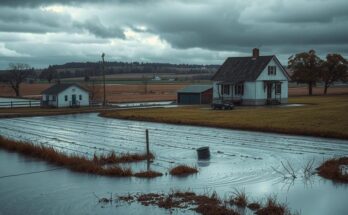A report from WaterAid reveals that major cities worldwide are facing ‘climate whiplash,’ characterized by drastic weather extremes. Analysis of 100 populous cities over 40 years shows 95% trending toward wetter or drier conditions, threatening water access, sanitation, food security, and community health. Cities like Nairobi and Los Angeles are experiencing significant challenges, necessitating urgent adaptive strategies.
A newly commissioned report by NGO WaterAid highlights how major cities globally are grappling with ‘climate whiplash,’ which refers to the drastic shifts between wet and dry extremes. An analysis of climate patterns over the past 40 years in 100 populous cities revealed that 95 percent showed significant trends towards wetter or drier conditions. This has resulted in intensified flooding or droughts, affecting access to clean water, sanitation, and food, and increasing the risk of disease while displacing communities.
With over 4.4 billion people residing in urban areas, the demand on water supply, sewage systems, and flood protection is increasing. Climate change is further complicating existing infrastructure’s efficacy and making the development of new systems increasingly challenging. Professor Katerina Michaelides from the University of Bristol noted, “Our study shows that climate change is dramatically different around the world.” Regions such as Europe and the Arabian Peninsula experience dryness, contrary to south and southeast Asian cities, which face heavy rainfall and flooding.
Moreover, more than 20 percent of the cities examined are undergoing shifts in climate patterns, leading to wetter or drier conditions. The rising temperatures enhance these extremes, as warmer air retains more moisture during dry spells and results in torrential rain. Cities like Cairo and Madrid have noted the most significant transitions, while Hong Kong is also among those impacted.
The consequences of prolonged droughts include water scarcity, disrupted food supplies, and power outages, as witnessed during Brazil’s severe drought last year. Conversely, floods contaminate drinking water sources, destroy crops, and adversely affect livestock, severely damaging essential infrastructure.
Cities facing climate whiplash endure the worst of both scenarios, as demonstrated in Nairobi, Kenya, where cycles of drought have led to loss of water, crops, and livestock, then followed by flooding that resulted in displacement and loss of livelihoods. Similarly, Los Angeles witnessed wildfires fueled by an accumulation of vegetation from a previous wet season, illustrating the severe impact of these rapidly changing weather patterns.
The alarming findings of the WaterAid report underscore the urgent need for cities to adapt and build resilience against climate whiplash. With notable cities particularly affected by these extreme climate fluctuations, the implications for clean water access, food security, and overall community health are significant. As climate change evolves, informed planning and innovative infrastructure solutions become paramount to safeguard urban populations from the adverse impacts of these unprecedented weather events.
Original Source: macaonews.org




